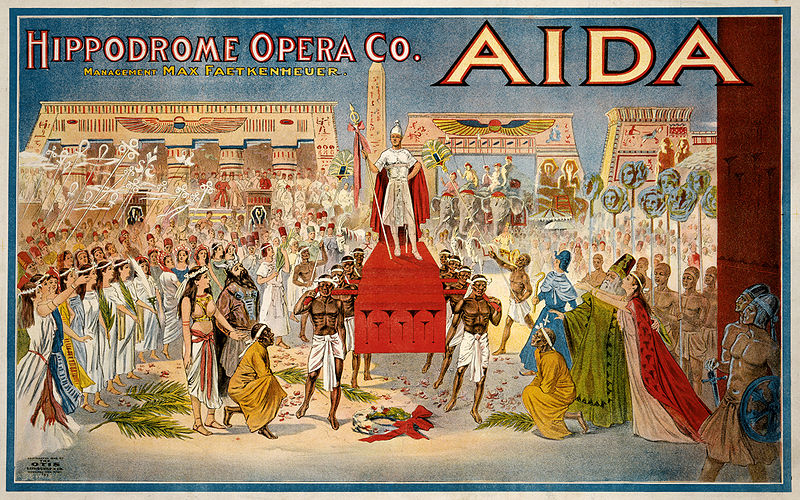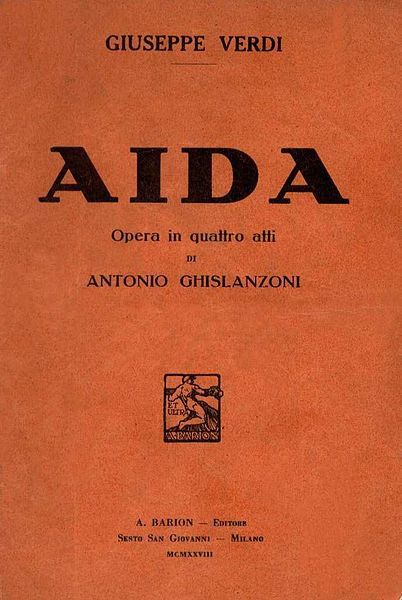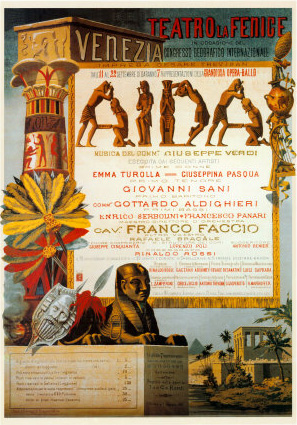Music with Ease > 19th Century Italian Opera > Aida (Verdi)
Aida
An Opera by Giuseppe Verdi

Poster for the opera, Aida, for a performance by the Hippodrome Opera Company (believed to be from Cleveland, Ohio) in 1908
ACT 1. -- The curtain rises on the garden of the Royal Palace at Memphis. Ramfis, the high priest, enters to announce to Radames, Captain of the Royal Guard, that the Ethiopians are in revolt. The sacred Isis has been consulted, and has named the warrior who is to crush the revolt. Radames, in love with Aida, hopes that he may be the leader chosen by the deity, so that, as his reward, he may have the hand of Aida, the favourite slave of Princess Amneris, daughter of the King. Aida is, however, much distressed at the situation; for the Ethiopian rebels are her kinsmen, and their King, Amonasro, is her father. Moreover, Amneris herself loves Radames; and, his ambition realised (for the deity’s choice had fallen on him), she and her unconscious rival, Aida, speed him on his way to the temple to ask a blessing on his arms.
ACT 2. -- This Act opens in a room in the palace of Amneris. Here Aida confesses her love for Radames. A violent scene of jealousy follows, interrupted by the triumphal return of Radames after a victory over the unfortunate Aida’s father, who appears among a group of prisoners paraded in a procession. The Act ends with the King’s unexpectedly giving his daughter Amneris to Radames, as a reward for his success, much to the distress of Radames, who wished for Aida.
ACT 3. -- Here we have Amonasro begging his daughter to steal from her lover, Radames, the secret of his military plans against the Ethiopians, who have again risen in rebellion. Aida promises, hoping to fly to her own land with her father and her lover. She obtains the secret from Radames, who is at once surprised and denounced by Amneris for his indiscretion.
ACT 4. -- Amneris would now be revenged on Radames. To make a last trial of his affection, she orders the guards to bring him to her presence. She then offers to secure his pardon by the King if he will accept her love. Radames refuses, not caring to have life without Aida. He is therefore sentenced to be buried alive in a vault beneath the temple. Aida voluntarily joins him; and the curtain falls on their lamentations, and the expression of their hopes of meeting in a better world.
In "Aida" we find a true wedding of text and music -- sustained dramatic power, noble orchestration; in short, "everything that distinguishes the great Verdi of the third period from the the palty Verdi of the first period." The work is powerful in characterisation, pathetic in sentiment, pure and elevated in style, dignified, solemn, and beautiful. Verdi’s sense of orchestral colour, always acute, had a fine opportunity of asserting itself in the Oriental subject, so remote from the usual operatic groove, and he used it to remarkable effect. Local colour is often a dangerous stumbling-block to composers, but in "Aida" Verdi triumphed most where most had failed. Mr. Streatfeild’s analysis brings this out very clearly. In the scene of the consecration of Radames, Verdi employs two genuine Oriental tunes with such consummate art that this scene is not only one the few instances in the history of opera in which Oriental colour has been successfully employed, but, in the opinion of many, the most beautiful part of the opera. Another splendid scene is the judgment of Radames, already referred to, in the fourth Act, where an extraordinary effect is gained by the contrast of the solemn voices of the priests within the chamber with the passionate grief of Amneris on the threshold. The love scene in the third Act shows the lyrical side of Verdi’s genius in its most voluptuous aspect. The picture of the palm-clad island of Philae and the dreaming bosom of the Nile is almost divinely mirrored in the score. The music seems to be steeped in the odorous charm of the warm southern night.
"Aida" was first produced, at Cairo, on December 24, 1871. When Verdi announced that his score was finished, he was offered money, honours, and decorations if he would go to Egypt and conduct it in person. But Verdi was quite content with the £4000 already paid for the work. Like Rossini and Grieg, he had a horror of the sea, and nothing would tempt him to make the voyage. And when professional critics went to Cairo to witness the performance and to report home, he was disgusted. Thus, to one he wrote, on the eve of his departure:
"It seems to me that art looked at in this way is no longer art, but a trade, a party of pleasure, a hunt, anything that can be run after, to which it is desired to give, if not success, at least notoriety at any price... I always call to mind with joy the early days of my career, the time when, with hardly a friend, with no one to talk about me, without preparation, without influence of any sort, I presented myself before the public with my works, and very happy if I could succeed in producing some slight favourable impression. Now what a piece of work about an opera!!! This is deplorable, deeply deplorable."

A libretto for Verdi's opera Aida published in the original Italian in Milan, Italy, in 1928. The full title reads "Aida, opera in quattro atti di Antonio Ghislanzoni, musica di Giuseppe Verdi" (Aida, an opera in four acts, by Antonio Ghislanzoni, music by Giuseppe Verdi).
It is to the critic to whom this was addressed that we owe the essential facts about the Cairo performance. He tells that the curiosity, the madness of the Egyptian public to hear "Aida" were such that all the seats were bought up a fortnight before, and at the last moment speculators "sold boxes and stalls for their weight in gold." The spacious theatre, crowded from top to bottom, "blazed with fantastic dresses and showy uniforms, and the curtain rose on a drama which gave a glimpse to the Arabs, Copts, and Franks present of the life and religion, the loves and the hates of ancient Pharaonic times." When it was all over, not a single voice was heard to dissent against the universal verdict of success.
"Aida" was represented at Milan soon after its production at Cairo, and there also its reception was brilliant and spontaneous. The opera rapidly made the tour of Italy and excited general enthusiasm. Only one protest is recorded, and it was so novel that it must be mentioned. A certain person named Bertoni went from a neighbouring village to hear the opera. His outing, including supper, cost him 15 francs 19 centimes. He happened not to like "Aida." However, next day, hearing it praised on all hands, he resolved to give it another trial. This time he spent 20 francs, and was no better pleased. Full of wrath, he wrote to Verdi telling him the opera was a failure, and asking him for a return of 35 francs 19 centimes, which sum, he alleged, he had wasted in going to hear it. Verdi was not offended; in fact, he sided with the aggrieved one. Taking a pen in hand, he authorised his publisher to send Bertoni 31 francs 50 centimes, adding: "It is not quite so much as the gentleman demands, but then could have had his supper at home." The story may not be true, but, as a witty Frenchman once said of a similar tale, "Si non e Verdi, e ben Trovatore."
AIDA POSTER

Aida (by Giuseppe Verdi).
Size: 19.69 in x 27.56 in.
Art Print.
Buy at AllPosters.com
Music With Ease | About Us | Contact Us | Privacy | Sitemap | Copyright | Terms of Use © 2005-25 musicwithease.com. All Rights Reserved. |
